Somnath is a veritable treasure trove of pilgrimage locations, all clustered around the famous Jyotirlinga temple.
Somnath Temple – Rising Phoenix
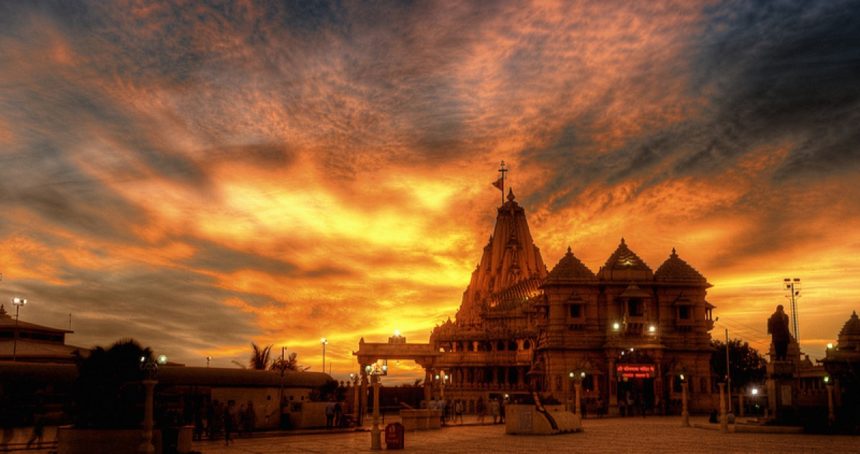
Introduction
The holy city of Somnath has been an important pilgrimage site for Hindus since ancient times, as it is considered to be the first among the 12 Jyotirlinga shrines of Lord Shiva. It is believed that Lord Shiva appeared at the Jyotirlinga sites as a fiery column of light at the dawn of the universe.
The famous ‘Triveni Sangam’, which is the confluence of the three rivers, Kapila, Hiran, and Saraswati (now extinct) is also situated here. Apart from the Somnath temple, this place is considered as the final resting place of Krishna who came here after the end of Mahabharata war. The town is also linked with Parshuram, the Pandavas, Sun worship & Adi Shankaracharya and hence has been at the center of religious activities since olden times.
At Somnath, Lord Shiva exists as ‘Lord of the moon’. It is the place where the moon got its waning power back by the grace of Lord Shiva. The origins of the Shiva Temple at Somnath are lost in the mists of time. Existing historical records show that a temple was built at this site by Yadav Kings of Vallabhi around 649 AD. The west coast of India was bombarded by Islamic invasions which resulted in the Somnath Temple being destroyed, desecrated and looted several times which led to the massacre of numerous Hindus as well.
It is widely known that Somnath was looted during 1072 by the barbaric Turkish invader, Mahmud of Ghazni. But it is not so well known that Somnath was earlier destroyed during the 8th century by Arabs and was rebuilt by King Nagabhata II in 815 CE. Due to the deep reverence held by Indians for Somnath, the temple has always been rebuilt after every ruination. It was also destroyed by Alauddin Khilji’s generals in the 13th century, by the Portuguese in the 16thcentury and finally by Aurangzeb in 1702 CE. It was the Mughal emperor Aurangzeb, who proclaimed that the place would be demolished completely if Hindus attempted to revive worship there. So much for the non-religious nature of these events.
It was only after India’s independence in 1947 that Deputy Prime Minister Sardar Vallabh Bhai Patel ordered the reconstruction of the Somnath Temple. Dr. Rajendra Prasad, the first President of India gave the task of reconstruction of the temple to Mr. K.M.Munshi, the head of the temple trust. It may amaze those who are not aware of the medieval history of India that a mosque was present at the exact sacred site and was shifted to build the current temple at the same site.
The present Somnath temple has been reconstructed in the Chalukya style of temple architecture.
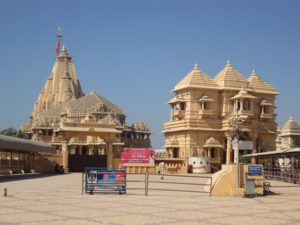
The Somnath Temple is open throughout the day and therefore is convenient for the devotees. During Aarti, the devotees inside the sanctum sanctorum actually move away from the line of sight of the Shivlinga to help those behind to have a darshan.
The Krishna Linkage
Somnath is inextricably linked to the story of Lord Krishna and his passing. Krishna created his kingdom at the fabled Dwarka and ruled from there after the great war of Mahabharata was over. After the demise of Pandavas and the destruction of his clan due to an internecine war, he felt that the time had come to leave this world. It was to the holy Somnath that he came at this point of time.
When Krishna was sleeping under a Peepul tree, a hunter named Jara mistook his feet for a deer and shot an arrow, grievously wounding him. The location of this tree has been converted into a temple called Bhalka Teerth.
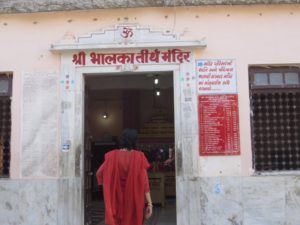
The marble image of Lord Krishna inside this temple is so sublime that it casts a spell of devotion in every pilgrim. Krishna becomes the surrounding, the present, the universe. The tree under which Krishna was hurt is also represented inside the temple.
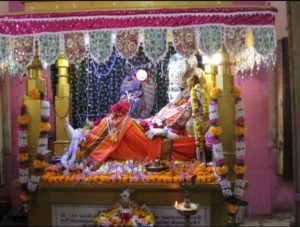
After getting injured, Krishna went to the holy Triveni Sangam at the banks of Harini River and took a bath. It is around 4 km away from the place where he was fatally injured by the arrow. This Sangam is just beyond the main Somnath temple complex area.
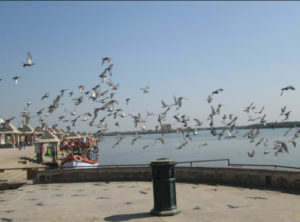
[Ghat at the Triveni Sangam area]
A few meters away from the Sangam area is the place where Krishna shed his mortal body. This place is called Dehotsarg (literally meaning “leaving the body”) or Golokdham Teerth. It is a quaint place on the banks of the river Hiran with two main temples – The Geeta Temple and the Lakshmi Narayan Temple.
The Geeta temple is a beautiful pink stone structure with polished marble inside. It is said to be located at the exact spot where Lord Krishna finally rested after his injury.

The murti of Krishna is of his avatar as the Muralidhar (flute holder), always accompanied with a cow, depicting his childhood days.
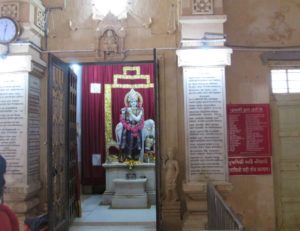
This temple is at a peaceful location matching with the sombre reality of being associated with the death of an Avatar of Vishnu. The writings of the 18 chapters of the Gita have been inscribed on the 18 pillars inside this temple. The temple has depictions from Krishna’s life as paintings on the walls. The sound of bhajans echo inside the hall gave a divine effect.
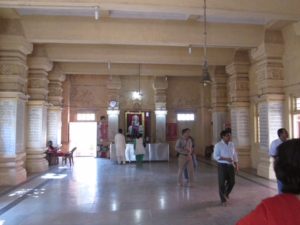
The Lakshmi Narayan temple is dedicated to Lord Vishnu along with his wife, Goddess Lakshmi, inside the temple. It is a beautiful marble structure with scenes from the Puranas and other scriptures depicted inside the temple.
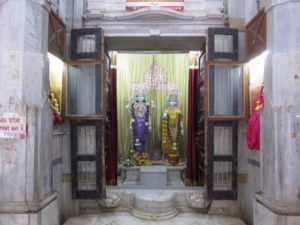
The whole complex is located beside the calm waters of the river Harini (Golokghat) and the peaceful area with its ever-present water birds enhance the beauty and serenity of the location.
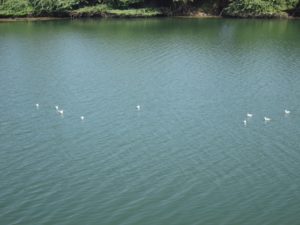
Apart from these two main temples, there are many other smaller shrines on this serene campus.
There is a canopied structure where Krishna’s feet are depicted in marble. This is called Krishnacharan Padukaji. There are other smaller shrines like the Kashi Vishwanath temple, Bhimnath temple and Shri Mahaprabhu Baithakji. The Baithakji represents is the location where Vallabhacharya gave a discourse on the Gita. There is a small shrine called Baldev ki Gufa. Baldev is the affectionate name of the elder brother of Lord Krishna, popularly known as Balram. He is also known as the reincarnation of Lord Vishnu’s serpent, The Adishesha. After Lord Krishna’s departure from this world, Balram also took his leave from this world and proceeded to Vishnu Lok via the underground cave at this location.
This Triveni Sangam is known as the place for penance to wash away one’s sins since ancient times. It is evident from the fact that this site is associated with the sage Parshuram, who is the sixth avatar of Lord Vishnu. In this reincarnation, he has taken up the duty of cleansing the earth of the rapaciousness of kings and ruling classes so ad to re-establish Dharmic principles. He had decimated such kingdoms repeatedly. It is said that Parshuram came here to do penance for his violent acts. These Ghats are considered holy to this day and pilgrims come here from all parts of the world to take a holy dip in the venerated Sangam waters.
There is a peaceful temple away from the roadside crowd, dedicated to Parshuram near the Triveni Ghats.
Parshuram Temple
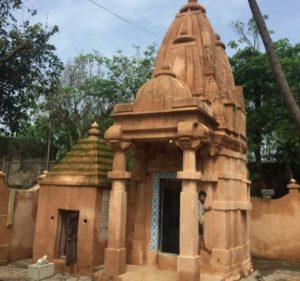
There is a life-size statue of Parshuram inside the temple. It is an unusual depiction as it shows him having a bow and arrow instead of the real weapon associated with him, which is a Parashu (battle axe).
Parshuram has a unique status among the various avatars as he has been associated with most of the epic events across time zones in ancient India. Apart from his early exploits in Treta Yuga where he donned the role of a relentless crusader for establishing Dharma, he is mentioned in the Ramayana where he appears at the point when Rama breaks the strings of the mighty bow of Shiva at Sita’s Swayamvar.
In the Mahabharata, he fought with Bhisma and later he imparted the knowledge of advanced weaponry to Karna. It is intriguing to note that he was present in widely differing time periods and there is no mention in any scriptures or in any associated folklore about his death or him going back to Vishnu Lok.
Other pilgrimage locations
There are other shrines in the vicinity of Triveni Sangam and the Dehotsarg temple complex. Just opposite the Triveni Sangam ghats, alongside the road, stands the Kamnath Mahadev Temple. This is associated with the story of the opening of Shiva’s third eye to destroy Kama Dev, hence it is called Kamnath Mahadev. There is a water tank associated with healing powers inside the temple complex.
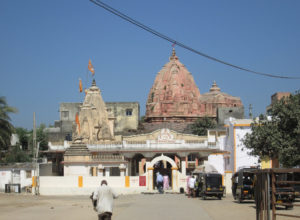
This is the place where Adi Shankaracharya is supposed to have meditated for a long period during his travels throughout India.There is a cave that is supposed to be the exact location of where he meditated.
Behind this temple stands the ancient Sun temple situated on a small mound. It is one of the oldest places of Sun worship in India. One needs to walk along a side passage to reach this temple, where the Sun is worshipped as the main deity.
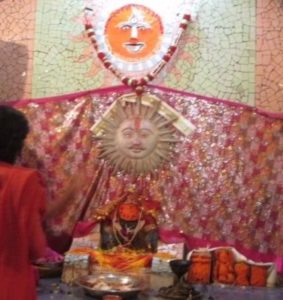
On one side of the sun temple, there is a shrine of a Nag. It is a unique case as the snake is depicted as a deity on its own, instead of being along with a Shivalinga.
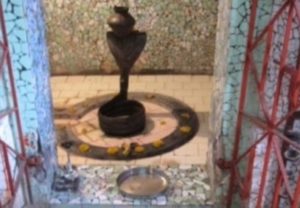
Near the sun temple, there is the Hingalaj Mata cave complex where Pandavas worshipped the Devi.
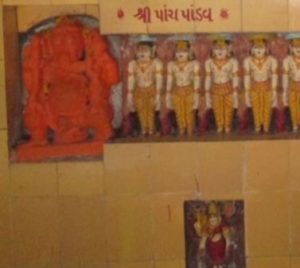
The local lore maintains that this chamber was created by the Pandavas in one day. The steps are really narrow and one has to really squeeze oneself to enter the chamber. It is a wonder how it would have accommodated the Pandavas (unless they were really famished due to their frequent travels to these faraway lands). They were present in this area for some time during their 13 year period of exile from Hastinapur. These are intriguing sites and leaves one wondering as to how the Pandavas must have roamed far and wide across the whole countryside leaving their footprints and memories with the local population everywhere.
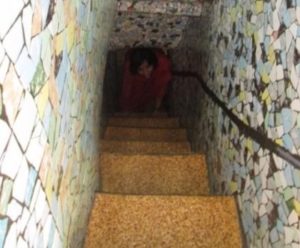
The stairs lead to a chamber of worship around 4 feet high. There is a vermillion symbol of Hingalaj Mata inside this chamber.
Conclusion
There are very few locations in India with such diverse linkages with ancient events. Across ages, devout pilgrims have flocked to Somnath as it is considered a spiritually charged place. The presence of the Jyotirlinga, representing the time at the very start of the universe, the confluence of the three rivers (Triveni) near the seashore, and the fact that this is the place directly associated with the advent of Kaliyuga (generally accepted to have started at the time of the death of Lord Krishna), makes Somnath one of the most revered places of pilgrimage in India. Much before the concept of recorded history began, Parshuram came here to gain peace after his long campaign against the wayward kings. Even Krishna, who established and ruled in Dwarka, chose this place for his departure from this world. Adi Shankaracharya, who traversed the whole of India to rekindle spirituality, also spent time here meditating. It is no wonder that Somnath has a special place in the heart of every pilgrim and the tradition of pilgrimage to this holy place has continued with unabated enthusiasm.

Leave a Reply